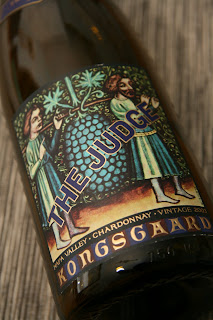
John Kongsgaard and Chardonnay joined forces already in the early 1980s, when John worked at the legendary Napa Valley winery Stony Hill, and later on from 1986 to 1996 at Newton Estate up at Spring Mountain. There, the wild fermented Unfiltered Chardonnay became an eye opener for chardonnays to many consumers. Today Chardonnay is the most important noble grape variety of California, and there’s hundreds and hundreds of chardonnays to be found.
He started his own label in 1996 when working with Fritz Hatton at Arietta, a winery he later on left to focus on his own wines. Nowadays he lives up at Atlas Peak, where he has dug a cave into the mountain at his 61 hectare estate. His regular Napa Valley Chardonnay is very good, but it is always the rare top cuvée The Judge, named in honor to his father, that ranks among the best chardonnays in California. Grapes are sourced from the Stone Crest Vineyard in Coombsville in the cooler southern part of Napa Valley, they are whole bunch pressed and the grape juice is then slowly fermented during several months in new French oak barrels, where the wine will undergo full malolactic fermentation and spend up to two years.
2003 Napa Valley Chardonnay The Judge / 95
I compared this wine with several great California chardonnays from vintages 2004 and 2005, and this wine was significantly more golden in color. However, after tasting it, I didn’t think of it as more matured, rather as a more concentrated wine. When poured from the bottle, it was rich and ripe with a sweet butterscotch note – all this which is expected in a young full malolactic barrel fermented chardonnay. However, the oak was well integrated, at this stage only showing some vanilla notes and just a hint of spiciness on the palate. Instead, there’s a lot of flavour and a full body to match the oak and surprisingly moderate alcohol (14.1 percent), and although this is a full malolactic wine, there’s a quite good acidity. Again, just like all great chardonnays of California, the true personality and complexity of this wine is revealed only after a proper serving procedure – it really needs decanting and a slightly higher serving temperature, let’s say 30-40 minutes in a decanter and 12-14 degrees as serving temperature. On the palate, the wine is very intense and rich with sweeter notes of fruit, alcohol and oak, but there’s also a fresh acidity that gives elegance and balance to the wine. I once told John Kongsgaard I thought this wine lacked structure and acidity, and still I do. However, I would lie if I told people I don’t like it. Summarizing my tasting notes, they actually really remind me on my tasting notes of Bâtard-Montrachet from quite good producers. And that's not too bad. Drink it over the next 2-6 years.
He started his own label in 1996 when working with Fritz Hatton at Arietta, a winery he later on left to focus on his own wines. Nowadays he lives up at Atlas Peak, where he has dug a cave into the mountain at his 61 hectare estate. His regular Napa Valley Chardonnay is very good, but it is always the rare top cuvée The Judge, named in honor to his father, that ranks among the best chardonnays in California. Grapes are sourced from the Stone Crest Vineyard in Coombsville in the cooler southern part of Napa Valley, they are whole bunch pressed and the grape juice is then slowly fermented during several months in new French oak barrels, where the wine will undergo full malolactic fermentation and spend up to two years.
2003 Napa Valley Chardonnay The Judge / 95
I compared this wine with several great California chardonnays from vintages 2004 and 2005, and this wine was significantly more golden in color. However, after tasting it, I didn’t think of it as more matured, rather as a more concentrated wine. When poured from the bottle, it was rich and ripe with a sweet butterscotch note – all this which is expected in a young full malolactic barrel fermented chardonnay. However, the oak was well integrated, at this stage only showing some vanilla notes and just a hint of spiciness on the palate. Instead, there’s a lot of flavour and a full body to match the oak and surprisingly moderate alcohol (14.1 percent), and although this is a full malolactic wine, there’s a quite good acidity. Again, just like all great chardonnays of California, the true personality and complexity of this wine is revealed only after a proper serving procedure – it really needs decanting and a slightly higher serving temperature, let’s say 30-40 minutes in a decanter and 12-14 degrees as serving temperature. On the palate, the wine is very intense and rich with sweeter notes of fruit, alcohol and oak, but there’s also a fresh acidity that gives elegance and balance to the wine. I once told John Kongsgaard I thought this wine lacked structure and acidity, and still I do. However, I would lie if I told people I don’t like it. Summarizing my tasting notes, they actually really remind me on my tasting notes of Bâtard-Montrachet from quite good producers. And that's not too bad. Drink it over the next 2-6 years.



No comments:
Post a Comment